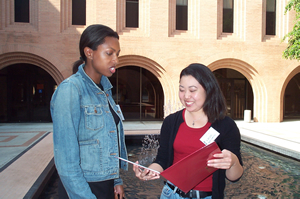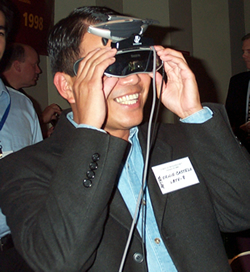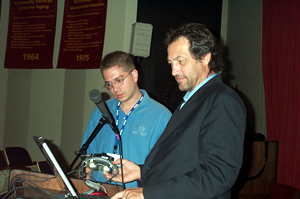|
 It
was a really terrific workshop APTRA had Saturday, October
25th at USC. It was all about what could happen when virtual
reality and TV news reporting collide. As President of APTRA,
my thanks to Skip Rizzo and everyone at USC for making it
possible. Skip has made something else possible too. Click
this link and it will take you to some of powerpoint presentations
made at the workshop. Thanks Skip! That address is ftp://imsc.usc.edu/pub/uploads/Skip's%20Stuff/APTRA%20Talks/
I'd also like to thank Bess Hubbard and Karen Matsumoto who
were at the seminar and wrote a piece on it to share with
those who couldn't make it. Here's their story. It
was a really terrific workshop APTRA had Saturday, October
25th at USC. It was all about what could happen when virtual
reality and TV news reporting collide. As President of APTRA,
my thanks to Skip Rizzo and everyone at USC for making it
possible. Skip has made something else possible too. Click
this link and it will take you to some of powerpoint presentations
made at the workshop. Thanks Skip! That address is ftp://imsc.usc.edu/pub/uploads/Skip's%20Stuff/APTRA%20Talks/
I'd also like to thank Bess Hubbard and Karen Matsumoto who
were at the seminar and wrote a piece on it to share with
those who couldn't make it. Here's their story.
 Virtual
Reality and Television News, Virtual
Reality and Television News,
or News in the Round – Can It Work?
By Karen Matsumoto and Bess Hubbard
Virtual Reality has merged its way into the realms of our
technological superhighway. We’ve seen it in video games,
theme park attractions and Internet sites, bringing life to
the ol’ 2-dimensional tunnel. But are we ready for virtual
reality’s invasion of the news media?
 In
Los Angeles last weekend, Integrated Media Systems Center,
in collaboration with Annenberg School of Journalism at the
University of Southern California, presented its study of
Virtual Reality TV News. This event, hosted by APTRA president
Hal Eisner, brought to USC the first group of media professionals
to get a sneak peak at this new technological breakthrough.
This ground-breaking project, funded by the National Science
Foundation, uses a “360-degree panoramic video camera”
to videotape a news story. The camera is actually 5 digital-video-cameras-in-one
shooting in every direction at once. The images are then digitally
aligned into one seamless 360-degree “environment”
that the audience would watch at home using a “Virtual
Reality Head Mounted Display.” The VR display –
a device that looks like a pair of bulky ski goggles –
literally places the viewer in the same “environment”
as the reporter, letting you choose what you want to observe
by simply turning your head, as you would in real life. Unlike
normal two-dimensional “on-the-scene” reporting,
virtual reality gives the viewer much more control over what
you see – virtual reality throws you right in the middle
of the action! In
Los Angeles last weekend, Integrated Media Systems Center,
in collaboration with Annenberg School of Journalism at the
University of Southern California, presented its study of
Virtual Reality TV News. This event, hosted by APTRA president
Hal Eisner, brought to USC the first group of media professionals
to get a sneak peak at this new technological breakthrough.
This ground-breaking project, funded by the National Science
Foundation, uses a “360-degree panoramic video camera”
to videotape a news story. The camera is actually 5 digital-video-cameras-in-one
shooting in every direction at once. The images are then digitally
aligned into one seamless 360-degree “environment”
that the audience would watch at home using a “Virtual
Reality Head Mounted Display.” The VR display –
a device that looks like a pair of bulky ski goggles –
literally places the viewer in the same “environment”
as the reporter, letting you choose what you want to observe
by simply turning your head, as you would in real life. Unlike
normal two-dimensional “on-the-scene” reporting,
virtual reality gives the viewer much more control over what
you see – virtual reality throws you right in the middle
of the action!
 Dr.
“Skip” Rizzo, Director of IMSC’s Virtual Environment
Lab at USC, explained that the VR Head Mounted Display is
one of three ways the lab displays “news in the round”
as part of an experiment that looks at the usability of this
new way of viewing news, and its impact on the viewer’s
ability to remember and empathize with a story. Dr.
“Skip” Rizzo, Director of IMSC’s Virtual Environment
Lab at USC, explained that the VR Head Mounted Display is
one of three ways the lab displays “news in the round”
as part of an experiment that looks at the usability of this
new way of viewing news, and its impact on the viewer’s
ability to remember and empathize with a story.
Dr. Rizzo and his researchers began by producing a mock television
news story about homeless life on Skid Row in downtown Los
Angeles, featuring USC graduate student Naomi Worrell as reporter.
Then the research team arranged for three different groups
of viewers to watch the news story in three different ways.
One group views the story in the traditional way, on a television
screen just as they would at home. The second group watches
a 360-degree presentation on a computer screen, using the
cursor to navigate around the picture’s panoramic arc.
The third group, using the VR head-mounted display, “stands”
on Skid Row with the reporter, able to observe the full panoply
of homelessness around them with a simple turn of the head.
This experiment will measure the viewer’s ability to
remember the news content, both short and long term. The experiment
will also look at whether VR’s ability to immerse a viewer
more deeply into the “environment” of the story
will increase the viewer’s empathy – making people
care is what journalism is all about. Results from this research
are expected to be available in December 2003, but that did
not stop symposium panelists and audience members alike from
speculating about these issues and more.
Some practical hurdles were immediately obvious. The 360-degree
panoramic video camera is bulky, and setting it up for a shoot
takes up to three hours. For a news team rushing to the scene
of a breaking news story, that much down time is an intolerable
delay. Also, Dr. Rizzo’s student-reporter felt uneasy
during her stand-up – it was hard to focus her attention
on an omni-directional camera. And as with all emerging technologies,
there is, of course, the question of cost – to the newsroom
and the viewer at home.
Some exciting possibilities also emerged. Certain kinds of
stories seem to lend themselves to VR – stories where
the event or the environment itself is the story. A 360-degree
view of the square in Baghdad where Saddam Hussein’s
statue was taken down amid a crowd of Iraqis and U.S. soldiers
would arguably be a more powerful – and more telling
– image than the usual 2-D flat screen. Broadcasting
in the round a story like southern California’s ongoing
battle with firestorms could be another visually arresting
opportunity. One news producer in the audience envisioned
the camera on top of a live truck during such an event, broadcasting
images live over a station’s website as an addition to
the daily newscast. Viewers could watch it play out panoramically,
or could navigate through the 360-degree space with the click
of a mouse. Another media professional imagined this camera
in the hands of the National Geographic or Discovery Channels,
capturing spectacular natural vistas from all sides at once.
The discussion – at once visionary and pragmatic –
explored a range of problems and possibilities: Could virtual
reality really work for television news? Would viewers enjoy
news in the round, or would VR create too much work for them?
Would a 360-degree perspective always enhance a news story’s
impact, or only certain kinds of stories? Would giving the
viewer more control empower the reporter – or make the
reporter obsolete? And would newsrooms and viewers ever be
able to afford the technology needed to produce, broadcast
and watch news-in-the-round?
There were no hard answers, but panelists and participants
alike enjoyed contemplating the possibilities.
|

















